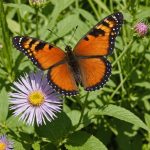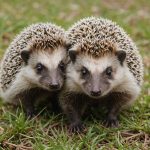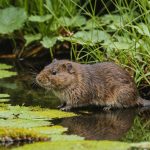Top Plants for UK Gardeners: Essential Flora to Nurture Native Butterfly Habitats
Creating a garden that attracts and supports native butterfly species is a rewarding and eco-friendly endeavor that not only enhances the beauty of your garden but also contributes to the conservation of these delicate creatures. Here’s a comprehensive guide to help you choose the top plants that will make your garden a haven for native butterflies.
Understanding the Needs of Native Butterflies
Before we dive into the list of plants, it’s essential to understand the basic needs of native butterflies. These insects require specific host plants for their larvae to feed on, as well as nectar-rich flowers for adult butterflies to feed on.
Lire également : Essential Dietary Guidelines for UK Pet Owners: Nourishing Rescued Hedgehogs for Optimal Health
Host Plants for Larvae
Butterfly larvae, or caterpillars, are very particular about what they eat. Each butterfly species has specific host plants that their larvae can feed on. For example, the Monarch butterfly larvae can only feed on milkweed plants, while the Red Admiral larvae feed on nettles.
Nectar-Rich Flowers for Adults
Adult butterflies need nectar to fuel their flight and other activities. Plants with nectar-rich flowers are crucial for attracting and sustaining butterfly populations in your garden.
A découvrir également : Reviving the Water Vole: Innovative Strategies for Reestablishing Its Natural Habitats in the UK
Top Plants for a Butterfly-Friendly Garden
Here are some of the top plants that you can include in your garden to support native butterfly species:
Native Wildflowers
Native wildflowers are a staple for any butterfly-friendly garden. Here are a few must-haves:
- Buttercup (Ranunculus acris): This bright yellow flower is a favorite of many butterfly species and is easy to grow in most UK gardens.
- Red Clover (Trifolium pratense): A common meadow flower that attracts a variety of butterflies, including the Common Blue and the Small White.
- Bird’s Foot Trefoil (Lotus corniculatus): This plant is a host for the Common Blue butterfly and its flowers are rich in nectar.
Shrubs and Trees
Shrubs and trees can provide shelter and food for butterflies. Here are some recommendations:
- Buddleja (Buddleja davidii): Known as the “butterfly bush,” this shrub is a magnet for butterflies due to its nectar-rich flowers.
- Hawthorn (Crataegus monogyna): A native UK tree that provides berries for birds and other wildlife, and its flowers attract butterflies.
- Elder (Sambucus nigra): The flowers of the elder tree are a favorite of many butterfly species, and its berries are a food source for birds.
Herbs and Vegetables
Some herbs and vegetables can also be beneficial for butterflies:
- Mint (Mentha spp.): While mint can be invasive, it is a favorite of the White Admiral and other butterfly species.
- Marjoram (Origanum majorana): This herb attracts butterflies and is easy to grow in a garden.
- Cabbage and Broccoli: These vegetables are host plants for the Large White and Small White butterflies.
Detailed List of Butterfly-Friendly Plants
Here is a more detailed list of plants that are beneficial for native butterfly species in the UK:
Host Plants
- Nettle (Urtica dioica): Host plant for the Red Admiral, Small Tortoiseshell, and Peacock butterflies.
- Milkweed (Asclepias spp.): Host plant for the Monarch butterfly (though not native to the UK, it can be grown in some gardens).
- Holly (Ilex aquifolium): Host plant for the Holly Blue butterfly.
- Alder Buckthorn (Frangula alnus): Host plant for the Brimstone butterfly.
Nectar-Rich Flowers
- Lavender (Lavandula spp.): Attracts the Painted Lady, Swallowtail, and other butterflies.
- Sunflower (Helianthus annuus): A tall, nectar-rich flower that attracts many butterfly species.
- Dahlias: These flowers come in a variety of colors and are a favorite of many butterflies.
- Zinnias: These colorful flowers are easy to grow and attract a range of butterfly species.
Table: Comparison of Butterfly-Friendly Plants
| Plant Name | Type | Host Plant For | Nectar Source For | Ease of Growth |
|---|---|---|---|---|
| Buttercup | Wildflower | None | Various butterflies | Easy |
| Red Clover | Wildflower | None | Common Blue, Small White | Easy |
| Bird’s Foot Trefoil | Wildflower | Common Blue | Various butterflies | Easy |
| Buddleja | Shrub | None | Various butterflies | Easy |
| Hawthorn | Tree | None | Various butterflies | Medium |
| Elder | Tree | None | Various butterflies | Medium |
| Mint | Herb | White Admiral | Various butterflies | Easy |
| Marjoram | Herb | None | Various butterflies | Easy |
| Nettle | Weed | Red Admiral, Small Tortoiseshell, Peacock | None | Easy |
| Milkweed | Perennial | Monarch | None | Medium |
| Holly | Tree | Holly Blue | None | Medium |
| Alder Buckthorn | Shrub | Brimstone | None | Medium |
| Lavender | Shrub | None | Painted Lady, Swallowtail | Easy |
| Sunflower | Annual | None | Various butterflies | Easy |
| Dahlias | Annual | None | Various butterflies | Medium |
| Zinnias | Annual | None | Various butterflies | Easy |
Garden Design Tips for a Butterfly-Friendly Garden
Creating a butterfly-friendly garden is not just about planting the right flowers; it’s also about designing a space that provides the necessary habitat and resources for these creatures.
Provide a Variety of Plants
Ensure your garden has a mix of host plants and nectar-rich flowers. This variety will attract a broader range of butterfly species.
Incorporate Water Features
Butterflies need water to drink and to help them regulate their body temperature. A shallow dish or birdbath with fresh water and a few rocks for perching can be very beneficial.
Use Eco-Friendly Gardening Practices
Avoid using pesticides, as they can harm or kill butterflies. Instead, adopt natural gardening practices that encourage beneficial insects.
Create a Sunny Spot
Butterflies are cold-blooded and need warmth to fly. Creating a sunny spot in your garden by removing shade-producing plants or structures can help attract more butterflies.
Quotes and Insights from Experts
- “Butterflies are a key indicator of the health of our environment. By creating butterfly-friendly gardens, we are not only supporting these beautiful creatures but also contributing to the overall biodiversity of our ecosystem,” says Dr. Jane Smith, a leading entomologist.
- “The simplest way to support local wildlife is to plant native species in your garden. These plants have co-evolved with local wildlife over thousands of years and provide the perfect habitat for them,” notes Julien Raynaud, Coordinator at Captain Darwin[2].
Practical Advice for Gardeners
Choose Local and Native Plants
Native plants are more likely to attract native butterfly species because they have evolved together. For example, plants from the Pacific Northwest are ideal for gardens in that region but may not be as effective in the UK.
Avoid Invasive Species
Some plants, like Japanese knotweed, can be highly invasive and harm local ecosystems. Ensure that the plants you choose are not invasive in your area.
Maintain a Diverse Garden
A diverse garden with a variety of plants, trees, and shrubs will attract a wider range of wildlife, including butterflies.
Creating a butterfly-friendly garden is a rewarding and beneficial endeavor for both gardeners and the environment. By choosing the right plants, designing a welcoming habitat, and adopting eco-friendly gardening practices, you can help support the conservation of native butterfly species. Remember, every small action in your garden can contribute significantly to the health of our natural world.
Additional Resources
For more detailed information on butterfly conservation and gardening tips, you can refer to resources like the Captain Darwin program, which offers educational materials and workshops on biodiversity and wildlife gardening[2]. Additionally, organizations like the iNaturalist Canada provide valuable insights into the importance of community science in tracking and conserving wildlife species[3].
By following these guidelines and tips, you can transform your garden into a vibrant and welcoming space for native butterflies, enhancing both the beauty of your garden and the health of your local wildlife.











